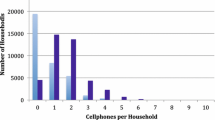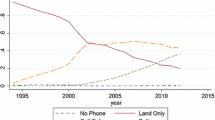Abstract
A telephone demand model (logit) is estimated with pooled Decennial Census data (1970, 1980 and 1990) for the states. Previous studies using pooled FCC penetration data are suspect due to large standard errors in the sample. Since our model includes data across time this allows the inclusion of long distance price and increases the variation in the standard variables. Time-effect dummy variables control for unobserved shifts in the data. Given that these dummy variables may pick up some of the effect of the long distance price, as well as other unobserved effects, their estimated impact is relatively small. Robust model results lead to the conclusion that elasticities decline through time. Furthermore, while subsidized penetration is more effective for targeted than untargeted programs, the cost per year of adding a household to the network is very high in either case (for 1990 about $5368 for untargeted; and for targeted $191 in 1990 and $1581 in 1998).
Similar content being viewed by others
References
Albery, B. 1995. “What Level of Dialtone Penetration Constitutes ‘Universal Service’?” Telecommunications Policy 19: 365–380.
Amemiya, T. 1985. Advanced Econometrics. Cambridge: Harvard University Press.
Amemiya, T. 1981. “Qualitative Response Models: A Survey.” Journal of Economic Literature 19: 1483–1536.
Cain, P., and J. M. Macdonald. 1991. “Telephone Economics Pricing Structures: The Effects on Universal Service.” Journal of Regulatory Economics 3: 293–308.
Chamberlain, G. 1982. “Analysis of Covariance with Qualitative Data.” Review of Economic Studies 47: 225–238.
Crandall, R. W., and L. Waverman. 2000. Who Pays for Universal Service? When Telephone Subsidies Become Transparent. Washington, DC: Brookings Institution Press.
Eriksson, R. C., D. L. Kaserman, and J. W. Mayo. 1998. “Targeted and Untargeted Subsidy Schemes: Evidence from Postdivestiture Efforts to Promote Universal Telephone Service.” Journal of Law and Economics 41: 477–502.
Garbacz, C., and H. G. Thompson, Jr. 1997. “Assessing the Impact of FCC Lifeline and Link-up Programs on Telephone Penetration.” Journal of Regulatory Economics 11: 67–78.
Garbacz, C., and H. G. Thompson, Jr. March 15, 1997. “Do Lifeline Programs Promote Universal Telephone Service for the Poor?” Public Utilities Fortnightly 135: 30–33.
Garbacz, C., and H. G. Thompson, Jr. 2000. “FCC Telephone Penetration Rate Data: A Caveat.” Telecommunications Policy 24: 969–979.
Garbacz, C., and H. G. Thompson, Jr. 2001. “Universal Service Versus Universal Competition: A Review Article of Crandall and Waverman.” Journal of Regulatory Economics 19: 93–96.
Gassner, K. 1998. “An Estimation Of UK Telephone Access Demand Using Pseudo-Panel Data.” Utilities Policy 7: 143–154.
Greene, W. 1997. Econometric Analysis 3rd. ed. New York: Prentice Hall.
Halvorsen, R., and R. Palmquist. 1980. “The Interpretation of Dummy Variables in Semi-Logarithmic Equations.” American Economic Review 70: 474–475.
Hausman, J., T. Tardiff, and A. Belinfante. 1993. “The Effects of the Breakup of AT&T on Telephone Penetration in the United States.” American Economic Review (American Economic Association Papers and Proceedings) 83: 178–184.
Johnson, L. L. 1988. Telephone Assistance Programs to Low-Income Households. R-3603-NSF/MF. Palo Alto: Rand Corporation.
Kaserman, D. L., J. W. Mayo, and J. E. Flynn. 1990. “Cross Subsidization In Telecommunications: Beyond the Universal Service Fairy Tale.” Journal of Regulatory Economics 2: 231–249.
Kaserman, D. L., J. W. Mayo, and P. L. Pacey. 1993. “The Political Economy of Deregulation: The Case of Intrastate Long Distance.” Journal of Regulatory Economics 5: 49–63.
Kennedy, P. 1981. “Estimation with Correctly Interpreted Dummy Variables in Semi-Logarithmic Equations.” American Economic Review 81: 801–802.
Klein, C. C., and D. B. Sapper. 2000. “Universal Service in Tennessee: A Pre-Competition Assessment.” Tennessee Regulatory Authority.
Maddala, G. S. 1983. Limited Dependent and Qualitative Variables in Econometrics. Econometric Society Monographs No. 3, Cambridge, England: Cambridge University Press.
Mueller, M. 1993. “Universal Service in Telephone History.” Telecommunications Policy (July): 352–369.
Parsons, S. G. 1998. “Cross-Subsidization in Telecommunications.” Journal of Regulatory Economics 13: 157–182.
Perl, L. J. 1983. Residential Demand for Telephone Service. White Plains: National Economic Research Associates.
Riordan, M. H. 2002. “Universal Residential Telephone Service.” In Handbook of Telecommunications Economics, edited by M. Cave, S. Majumdar, and I. Vogelsang. Elsevier.
Schement, J. R., A. Belinfante, and L. Povich. 1997. “Trends in Telephone Penetration in the United States 1984–1994.” In Globalism and Localism in Telecommunications, edited by E. M. Noam, and A. J. Wolfson. Elsevier, 167–199.
Taylor, L. D. 1980. Telecommunications Demand: A Survey and Critique. Cambridge, Mass: Ballinger Publishing Co.
Taylor, L. D. 1994. Telecommunications Demand in Theory and Practice. Kluwer Academic Press.
Wolak, F. A. 1996. “Can Universal Service Survive in a Competitive Telecommunications Environment? Evidence from the United States Consumer Expenditure Survey.” Information Economics and Policy 8: 163–203.
Author information
Authors and Affiliations
Rights and permissions
About this article
Cite this article
Garbacz, C., Thompson, H.G. Estimating Telephone Demand with State Decennial Census Data from 1970–1990. Journal of Regulatory Economics 21, 317–329 (2002). https://doi.org/10.1023/A:1015316632742
Issue Date:
DOI: https://doi.org/10.1023/A:1015316632742




